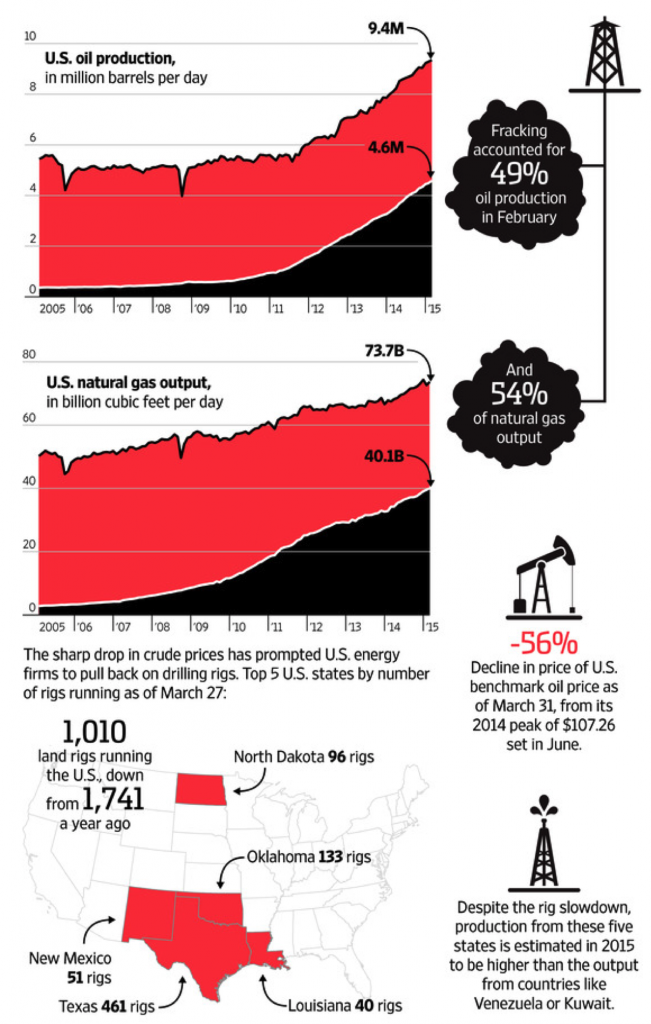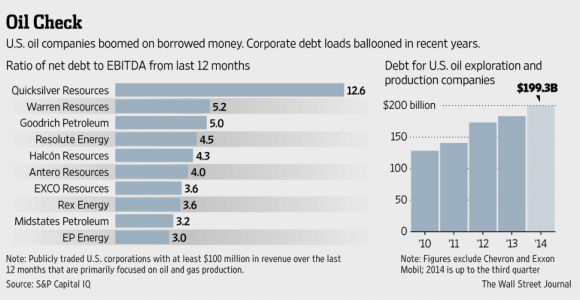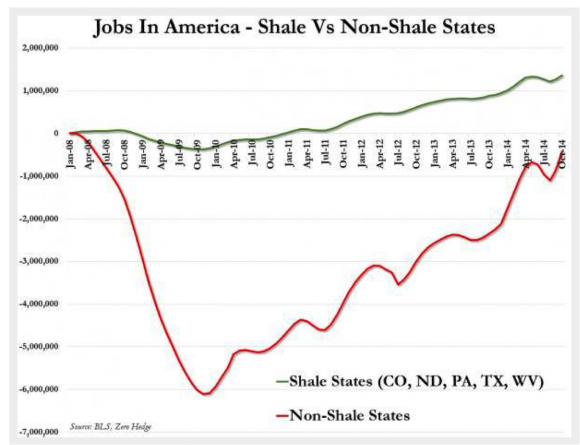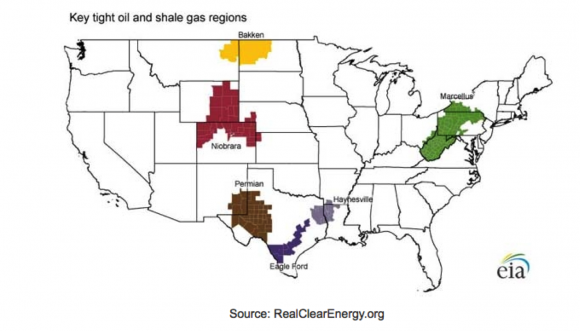Oil Sector Debt
America’s energy boom might sound like a great thing, but the drastic drop in prices is really a net negative for job creation, income growth, and the overall economy.
It’s been hard to miss the plummeting oil prices we’ve all enjoyed at the pump lately, and it’s been what seems like months since I’ve driven past a gas station, cursing and shaking my fist at the prices.
The United States is having an energy renaissance of sorts, but how? And to what end? What are the financial impacts of America becoming the world’s largest natural gas producer and outpacing the Saudis in oil production?
Chris Mayer, Agora Financial’s editor of Capital and Crisis and Mayer’s Special Situations, actually warned of this in his “Year-end Wrap-up” in December 2014, writing, “First, on a macro level, every dollar of revenue saved by oil users is offset by the loss of revenue to oil producers. This is a simple matter of logic that somehow nearly everyone overlooks.”
Even worse, there’s a ticking time bomb hidden deep within the U.S. oil patch — debt financing.
The cast of characters includes scrappy U.S. frackers, Saudi Arabia, banks and a whole ‘lotta unaware investors who could get walloped out of nowhere if they’re not careful.
It’s crucial to understand this looming threat and know how to protect your assets, so read on to connect the dots between the gas pump, the oil patch, and your wallet.
But before we get to this debt bomb’s countdown, let’s take stock of what’s happening in the oil markets right now.
Why Is the Price of Oil So Low?
Most people never really pay much attention to why the price at the pump is going up or down; they’re just happy to save a buck or miffed at the total. But complex financial relationships and emerging energy technologies have a lot to do with it.
Oil prices have dropped from roughly $100 a barrel to the $40-60 range, which is about a 40% decline. This is the fastest, steepest decline in oil prices since the mid 80s. And while commodities like oil can be volatile, this isn’t normal, folks.
Au contraire — this is what we’d call extreme.
In fact, this stark of a downturn has only happened in this short a period of time three times in the past 70 years. This is one of the largest declines in price in the 139-year history of daily prices, and the last time oil dropped so fast and furiously it marked the onset of the 2008 crisis. C’est vrai! [It’s true!]
This would be on par with something as dramatic as the Dow dropping 8,000 points.
I’ll let those warm and fuzzy facts sink in for a moment.
But why is the price of oil so low? There has to be an explanation, right?
There are actually several. Part of it has to do with something everyone is familiar with; supply and demand (more on that in a second), along with slowing economic growth, a stronger U.S. dollar, and less speculation.
But the straw that’ll break the camel’s back — as usual — is too much debt.
Debt, Loans, and Swap Contracts
Like any boom and eventual bust, it all starts with confidence and optimism in higher prices, which spurs investment and speculation. This almost always leads to more spending while the debt just racks up, until supply eventually begins to overwhelm demand.
Then, when excess supply drives down prices and leads to excess debt levels, the debt becomes unserviceable for the overleveraged, and you’re looking at a pretty big bust just waiting to happen.
Today’s energy sector appears to be heading in that very direction as debt becomes unserviceable and the inevitable defaults begin.
And it looks like the tumble isn’t over for oil any time soon. “Chances are that the free fall in oil prices isn’t over yet” predicted, Jonas Elmerraji in Penny Stock Fortunes last month. “Goldman Sachs recently said that they saw crude falling as low as $39. Other professionals are speculating that $20 oil is in our future.”
For his part, Jim Rickards, editor of Strategic Intelligence, believes oil is going to hover around $60, which is still a big deal and could cause damage to junk bonds and a lot of other markets.
But if oil is cheaper than ever, where did all this debt come from?
When oil producers went hunting for loans, industry models priced oil between $80 – $150 per barrel. While those numbers represent each “extreme” end of the cost spectrum, not a single oil company went out and borrowed based on the assumption they could still make money at $50 a barrel.
So, for example, an oil exploration company borrows a few hundred million to drill using fracking technology, from the bank, lender, bond investor, or whomever. When the lender of the money wants to know how the company is planning to pay them back, the oil company will tell them they will sell their oil at $80 a barrel, for example, and that’s how you’ll be reimbursed. But, how do the banks and lenders know if that price is spot on?
Well, they don’t. What happens is oil companies purchase a kind of derivative called a “swap contract” from a big bank like Morgan Stanley or Citibank as a way to lock in an oil price. This means Morgan Stanley agrees to pay the oil company the difference between $80 and the actual current price of oil. If oil goes to $60, according to the swap contract, Morgan Stanley has to pay the oil company the difference of $20.
It is through these swap contracts that the loss now shifts over to the bank, and the bank suffers the loss rather than the oil company.
Forbes explains:
It was a good plan, as long as oil prices stayed high. But now, with oil prices half what they were six months ago, there’s tremors in that debt mountain, and concerns that an avalanche could quickly take out the weakest oil companies, which simply won’t be able to generate sufficient revenues to service their debt. Not only that, their collateral is evaporating as well. Goldman Sachs analysts figure that $1 trillion of oil investments are virtually worthlessas long as prices stay this low, because marginal fields are simply not worth drilling.
As analyst Ed Westlake at Credit Suisse summed up the trouble in a recent note: “in four years of $100/bbl oil, the global oil and gas industry has taken on a quarter of a trillion dollars in debt, has delivered zero production growth outside of North America and is facing a $1 trillion+ reduction in global revenues.”
So, the banks get screwed with all the losses, right? Well, not necessarily. Like a never-ending game of telephone, the banks may have passed those losses right on over to you. Risk just keeps getting passed around and broken up into smaller bits.
You see, dear reader, the bank is just the middleman, and they may have very well also gone out and sold their contract elsewhere, like an ETF, which could be lurking in your portfolio. The buildup of leverage will ultimately hurt unsuspecting equity and debt investors (more on that later).
So now, all of a sudden, there’s a bunch of debt that producers will not be able to pay back with the money they make at $50 a barrel, and those debts will need to be written off.
Supply and Demand
As most people know, Saudi Arabia is the Top Dog marginal supplier, and they have the power to crank up the oil supply or dial it back as they see fit. And when you’re Top Dog, you can easily sniff around and find out what’s going on with your competition.
The Saudis are well aware that the U.S. is now the world’s largest energy producer and is close to becoming a net oil exporter, thanks to fracking technology. And even though supply is up, thanks to American oil production kicking tail, there’s no denying a global slowdown in demand because of an equally slow economy.
The Wall Street Journal offers a helpful infographic that explains fracking, reporting, “Hydraulic fracturing has unleashed vast new quantities of crude oil and natural gas. The percentage of fuel flowing from shale-rock compared with traditional oil and gas fields has been steadily rising. But lackluster energy demand and low prices are expected to curb growth later this year.”

You see, fracking has much higher costs, and Saudi Arabia has the edge simply because they have the lowest marginal cost of producing oil — meaning it could cost them as little as a couple bucks to get their oil up out of the ground. Because they only lose a few dollars in production, they can still make money on oil, even when it’s priced at $30-40 per barrel.
If Saudi Arabia can’t make fracking go away, they can try their damndest to bankrupt or seriously interrupt production on a lot of fracking companies. They want to get the price low enough to hurt the frackers, but they’ll have to find the sweet spot where the price not only hurts frackers, but does not hurt the Saudis.
This is tricky business, because the lower the oil price, the more money Saudi Arabia loses on profits. The Saudis are looking to find that number that will be low enough to hurt the fracking industry, and high enough so they can maximize their revenues.
This sweet spot number is about $60 per barrel.
Jim Rickards, editor of Agora Financial’s Strategic Intelligence, tells me:
Think of $60 per barrel as the sweet spot where we have all the bad stuff in terms of fracking — corporate bonds and junk bond defaults — but not so low that the Arabs hurt themselves more than necessary. Oil below $60 is more than low enough to do an enormous amount of damage in financial markets. Losses are all over the place. We don’t know necessarily where they are right now. But I guarantee there are major losers out there and they’re going to start to merge and crop up in unexpected places.
The first place investors can expect to see losses is in junk bonds, and according to Jim, in the last five years, there have been about $5.4 trillion of costs incurred for exploration and infrastructure in the fracking sector.
What Happens to the Debt?
Well folks, simply put, we could be looking at a tidal wave of defaults.
According to the Wall Street Journal, American oil and gas companies have gone into serious debt during the energy boom, and have increased borrowings by 55% since 2010, to almost $200 billion:
Their need to service that debt helps explain why U.S. producers plan to continue pumping oil even as crude trades for less than $50 a barrel, down 55% since last June. But signs of strain are building in the oil patch, where revenue growth hasn’t kept pace with borrowing.
Energy analysts warn defaults could be coming…oil is languishing at five-year lows…and natural-gas prices have fallen by 40% since June from about $4.70 per million British thermal units to less than $3. Despite the cold winter, companies in the U.S. have been pumping enough gas to fill up storage around the country to high levels not seen in nearly five years.

So let’s recap. The price of oil is low because of slow demand and global growth, and increased supply due to fracking. Fracking output costs money to develop, and a lot of that money was raised in the form of junk bonds. As I told you before, when those junk bonds were issued, the projects and people behind them assumed oil would be priced in a range from $80–130 per barrel.
With oil now hanging out in the $45–55 per barrel range, those projects are no longer profitable and the debt will begin to default in late 2015 or early 2016.
Where Will Losses Appear?
Now, who holds that debt, and where? As I mentioned before, junk bonds are the main culprit. But some of it might be in your 401(k) buried inside a “high yield” fund sold to you by your broker. This is something you might want to look into. Whether it’s owned by you or the bank across town, the essential point is that someone owns it, and whoever does is looking at an avalanche of write-offs coming straight their way.
In a broader scope, Forbes offers a useful list of companies that are in debt danger — i.e. those on shaky ground with the highest debt loads relative to operating income.
- Quicksilver Resources
- Goodrich Petroleum
- Swift Energy
- Sandridge Energy
- Energy XXI
- Connacher Oil & Gas
- Southern Pacific
- Midstates Petroleum
- American Eagle Energy
Since banks have several trillion dollars of exposure to oil and gas derivatives, it’s possible that the bottoming out of oil prices could set off massive losses for banks, even if their oil company clients survive somehow.
What You Can Expect
There are several issues we can expect to see when we experience this severe of a drop in energy prices:
Abandoned Oil
If the price of oil dips too low, it will just be left in the ground, untouched. Maybe you’re wondering why this is a bad thing, since I told you earlier that part of the reason we’re in this mess is an overabundance of supply.
But our modern world needs oil for anything and everything, from powering our cars, trucks, and buses and operating irrigation pumps for crops, to serving as a raw material for making countless products like textiles and medications.
Leaving even proven oil reserves underground leads to a rapid drop-off in production, and low prices have an array of secondary effects, from job loss, defaults resulting from deflation, collapse of oil exporters, and bank failures.
Shale and Offshore Drilling
Reuters reports that new oil and gas well permits fell by 40% in November of last year, and Bloomberg indicates that Transocean, the owner of the biggest fleet of deepwater drilling rigs, took a $2.76 billion charge among a drilling rig glut.
As you might suspect, shale operations have a huge impact on U.S. employment and job creation. The employment growth in states with current shale drilling is on a solid upswing, but compared to states outside of the shale game? Just take a look:

Source: http://www.zerohedge.com/news/2014-12-03/jobs-shale-states-vs-non-shale-states
Not so pretty. According to Zero Hedge, states with shale formation drilling have added 1.36 million jobs, while non-shale states have lost over 420,000 jobs. Even those states missing out on the shale benefits have flourished in a sense from the drilling, thanks to jobs only indirectly related to oil production, like a construction job building a new grocery store to serve a town’s booming population, for example.
Ultimately, everyone in the U.S. benefits from fewer oil imports from outside the country.
Debt Defaults
As I mentioned earlier, debt defaults have far reaching consequences for all of us. If these defaults become widespread enough, we could be talking about effects on things like bank deposits and international trade.
It’s becoming harder and harder for shale drillers to pay back their loans, thanks to lower cash flow and higher interest rates on new loans. Now, the massive debt taken on by shale drillers has become pretty risky [did you know that 16% of the junk bond market is made up of energy debt?].
Defaults could negatively impact banks if they hold loans that default; if securities they own related to oil loans default; if derivative defaults happen due to drastic changes in interest rates or currency levels; and if they need to quickly sell or buy securities related to ETFs.
If debt defaults spread, junk bonds and Letters of Credit could become crazy expensive for those companies with crappy credit ratings.
Exporting and Sales Abroad
There is a lot of hype surrounding the United States’ potential to sell crude and Liquified Natural Gas (LNG) abroad, but with low oil prices, that hope could evaporate faster than a puddle of gasoline simmering in the sun.
According to Investor Village, Asia has already stopped buying US crude oil since “there’s so much oversupply that Middle East crudes are now trading at discounts and it is not economical to bring over crudes from the US anymore.”
With lower prices overall, there isn’t much financial incentive to export crude and LNG abroad. And, as America’s trade deficit can tell you, our country is in dire need of increasing exportation.
What Does this Mean for Investors?
While I guarantee you’re scoffing into your coffee and thinking “boo-hoo, like I should be shedding a tear for those bloodsuckers in Big Oil,” the practical effects of significantly reduced oil prices and energy company revenues show up in damaging ways you need to know about.
The fracking sector is more at-risk than the traditional oil sector because the technology is brand spankin’ new and pricey, the majority of which has been financed with corporate and bank debt.
Another Credit Crisis?
It’s not rocket science; when oil prices go up, so does pretty much everything else, like food costs and the price of making most goods. So if oil rises, we typically see inflation. The opposite is true as well – we see lower prices in food and the cost of making goods along with low oil prices, or, deflation.
If the US experiences deflation, we are most likely going to have problems with massive debt defaults. Dwindling wages can make it hard for workers to repay loans, and there will likely be an outflow of investment funds, because investors realize that investments into these countries will not earn a decent enough return. Outflow of returns usually means harm to currencies, which could spell out trouble for the dollar.
There’s a lot of talk about how this deflation could spread to other sectors, like commercial real estate and beyond.
According to The Motley Fool:
“…the recent boom in shale oil and ultra-cheap credit has left many oil producers up to their eyeballs in debt. In a highly complex world, where junk bonds are owned by banks, investors, and even pension funds, a series of bond defaults could have a powerful domino effect that might impact not just the United States, but also global credit markets.
In addition, the decline in new oil investments could result in a large number of layoffs within the oil and gas industry, which is responsible for 7% of U.S. gross domestic product.Should energy bond defaults result in a credit crunch this could drastically lower the energy market’s access to credit in the coming years. That in turn could result in far slower oil production growth and higher energy prices in the future.”
How to Protect Yourself
There are two specific ways investors will lose; in the bond and equity sides of their portfolios. If you want to protect yourself, check to see if you have any second or mid-tier drilling and exploration companies in your portfolio (not something like Exxon Mobil – they are not going to go bankrupt). Look out for small, midsized companies because you could lose on the equity if they go bankrupt.
In terms of bonds, check your portfolio to see if you have any debt from these companies. In order to preserve your wealth, sometimes you have to turn to investments that offer interest. Unfortunately gold and Treasury bills pay you nothing, so some investors turn to a broker who might tell you they’ve got a bond fund that will pay you five or six percent, and a lot of unsuspecting people get involved with these bonds without looking what’s inside.
Our advice?
Look at the equity names in your portfolio, and in the bond part of the portfolio to see if any of these funds are holding notes or bonds issued by some of these companies. You’ll want to scan for small, mid-sized oil exploration and production companies particularly in the fracking industry (North Dakota, Pennsylvania, and Texas).

How to Profit
There may be bargains in the energy sector, but we’re personally not eager to dive in yet. Cycles take time to play out, and it could take years to wring out the credit excesses of the oil boom, just as it did with telecom.
While lower oil prices are good for consumers and real growth in the long run, they can be very bad for producers, disastrous if you’re a junk bond holder, and potentially misleading for Fed policy. Everyday Americans have good reason to both celebrate and fear this recent collapse in prices.
We’re all in agreement that the plunge in oil prices has battered revenues for energy producers and their companies, not to mention investor sentiment. But, if you’re more of a savvy bargain hunter who laughs in the face of fear, look at the companies that are raising funds to buy the battered bonds, stocks, and loans of energy firms. There is a nook here from which to profit if you’re bold enough to jump on the energy trade.
The Wall Street Journal reports:
Veteran hedge-fund manager Wilbur Ross, Blackstone Group LP’s GSO Capital Partners andApollo Global Management LLC are among those raising funds to buy the battered stocks, bonds and loans of energy firms following a 54% decline in New York crude prices since June.
More traditional investors like Western Asset Management Co. and Seix Investment Advisors LLC also have started funds to help large clients such as endowments and pension funds to place bets on the ailing energy industry.
Oil’s plunge to six-year lows has spurred an exodus from the securities of companies that explore for, produce, transport and refine oil and gas. The carnage is creating an opening for distressed investors, who snap up cheap stocks and bonds of troubled companies, seeking to profit when prices rebound or to use the investments to take the companies over in bankruptcy.
There are certainly those who are betting on the securities of those energy companies who will be hit by falling oil prices.
Impact on Monetary Policy
Every investor should consider the impact of rapidly falling prices on the Federal Reserve and U.S. monetary policy.
The Fed has a stated policy of achieving 2% inflation. As things currently stand, price indexes have shown outright deflation, the opposite of what the Fed wants. When looking at price data, the Fed focuses only on core inflation, which does not include the impact of food and energy prices on the economy. The spikes and dips of energy prices are easily ignored because they’re typically just monthly noise that ends up evening out over the course of a year or so.
When the Fed looks at price data, they focus on “core” inflation, which excludes the impact of food and energy prices. The basis for this is that food and energy prices are highly volatile and tend to track core inflation over long periods of time. You can ignore the spikes and dips of energy prices because they tend to be monthly noise, which evens out over the course of a year.
But what if this energy price drop is not just noise and it lasts for years? It’s not too crazy of a thought, since this drop is driven by geopolitical and macroeconomic forces that are not going away anytime soon.
Chris Mayer predicted this very scenario in the June 2012 issue of Capital and Crisis, back when oil was $80. He wrote, “I think the oil price will suffer from the oil shale boom. I also think the oil price will suffer from lousy demand… mine is a long-term call. I expect, in real terms, the price of oil will go lower in the next year and probably beyond.”
So far, Chris’s predictions have proved true.
If this long-term drop happens, the tried-and-true Fed approach would miss the significance of the move and underestimate the impact of the price drop and the deflation that comes with it.
This could mean a Fed interest rate hike in 2015 — as indicated will happen — just as persistent price drops are creating deflationary expectations and driving the economy into a recession. An interest rate bump on the verge of a recession is the worst possible medicine. But the Fed’s flawed models may be setting us up for just such an outcome.
The next year could be a bumpy ride as layoffs pile up and the bad debt starts rolling in, and even worse if the Fed decides to raise interest rates (more on that below).
Scour your portfolios and sell any bond funds stuffed to the gills with junk debt. You can use the proceeds from that to build cash positions and buy high-quality US Treasury notes. Cash preserves wealth while the notes produce gains in the deflationary times on the horizon. When we finally have more clarity about Fed policy, you can deploy your cash to buy distressed assets for cheap.
À tout à l’heure,
Genevieve LeFranc
for The Daily Reckoning
P.S. Be sure to sign up for The Daily Reckoning — a free and entertaining look at the world of finance and politics from every possible angle. The articles you find here on our website are only a snippet of what you receive in The Daily Reckoning email edition. Click here now to sign up for FREE to see what you’re missing.



Comments: